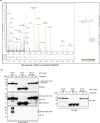Phosphoribosyl ubiquitination of SNARE proteins regulates autophagy during Legionella infection
- PMID: 40506485
- PMCID: PMC12317070
- DOI: 10.1038/s44318-025-00483-4
Phosphoribosyl ubiquitination of SNARE proteins regulates autophagy during Legionella infection
Abstract
Legionella pneumophila is an intracellular pathogen that causes Legionnaires' disease. The bacteria release effector proteins, some of which remodel host autophagic-lysosomal pathways. One such effector is RavZ, which delipidates ATG8 proteins, making compromising autophagy in Legionella-infected cells. Here we show that SidE effectors also affect these pathways, by mediating phosphoribosyl-ubiquitination (PR-Ub) of the autophagic SNARE proteins STX17 and SNAP29. STX17 modification induces recruitment of STX17-positive membranes from the endoplasmic reticulum to Legionella-containing phagosomes, forming replicative vacuoles. Using proximity labeling, biochemistry and Legionella infection studies, we define a mechanism by which autophagy is hijacked by bacteria to recruit ER membranes to the bacterial vacuole, via a structure bearing autophagy markers but not fusing with lysosomes. Mass-spectrometric identification of PR-Ub sites and mutational studies show that phosphoribosyl-ubiquitination of STX17 alters its interaction with ATG14L, which causes ER membranes to be recruited to the bacterial vacuole in a PI3K-dependent manner. On the other hand, phosphoribosyl-ubiquitination of SNAP29 inhibits the formation of the autophagosomal SNARE complex (STX17-SNAP29-VAMP8) via steric hindrance, thus preventing the fusion of bacterial vacuoles with lysosomes.
Keywords: Legionella pneumophila; Autophagy; Syntaxin17; Ubiquitin; Xenophagy.
© 2025. The Author(s).
Conflict of interest statement
Disclosure and competing interests statement. The authors declare no competing interests.
Figures











References
-
- Bhogaraju S, Kalayil S, Liu Y, Bonn F, Colby T, Matic I, Dikic I (2016) Phosphoribosylation of ubiquitin promotes serine ubiquitination and impairs conventional ubiquitination. Cell 167(6):1636–1649 - PubMed
MeSH terms
Substances
Grants and funding
LinkOut - more resources
Full Text Sources
Medical
Research Materials

